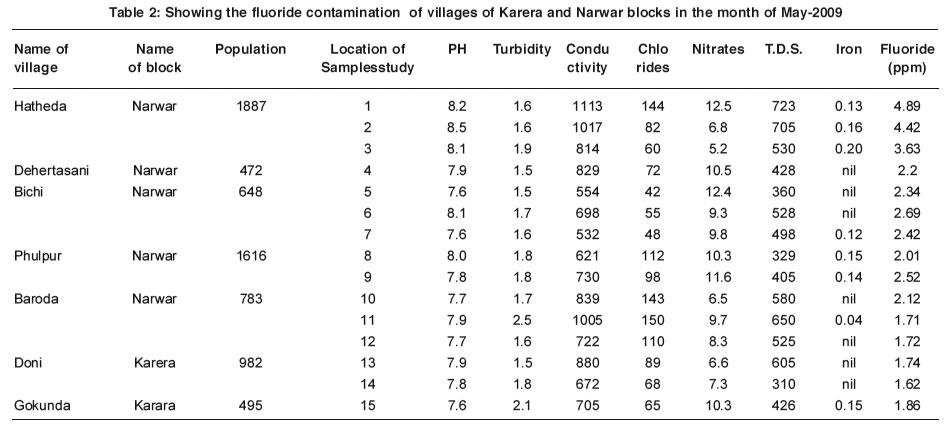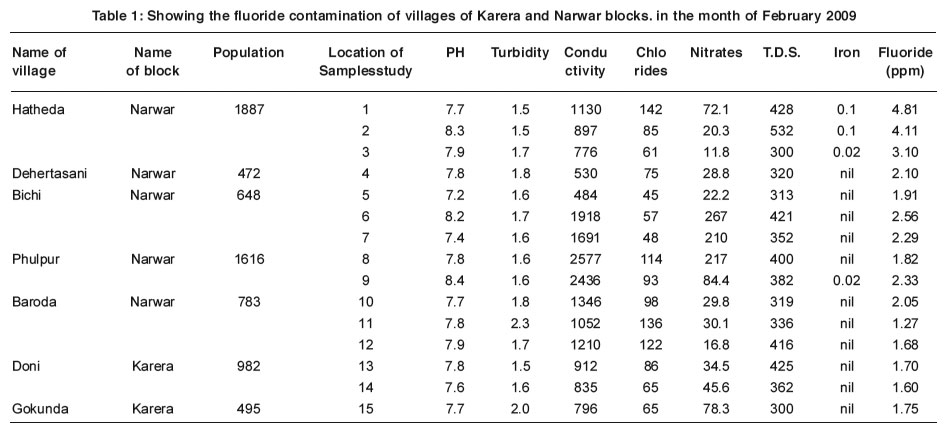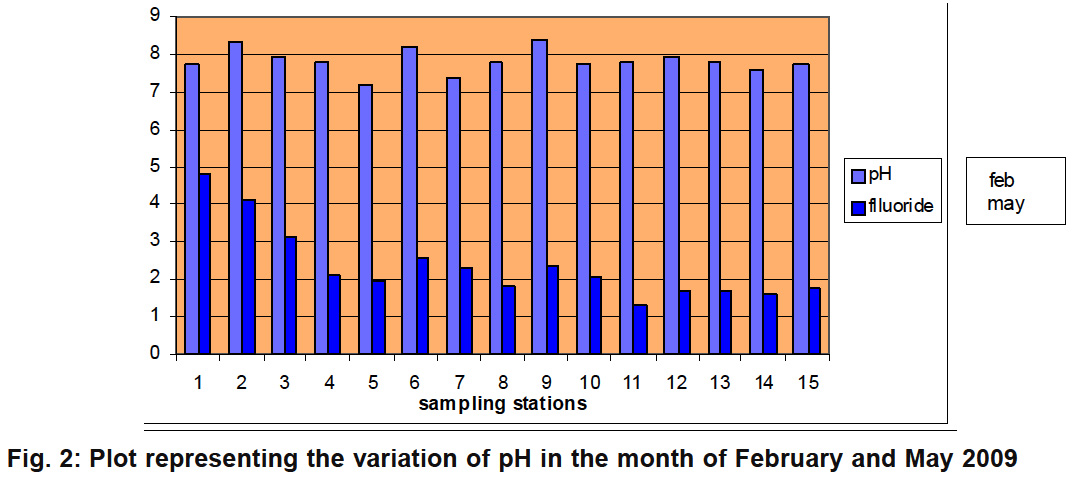A latest study for toxicity of fluoride in Karera and Narwar blocks of Shivpuri district (M.P.)
Meena Mourya1 * , Manisha Sonel2 , Bhavana Ayachit3 and Sudhanshu Dwivedi4
1
Institute of Research Technology and Science,
Bhopal,
India
2
Corporate Institute of Science and Technology,
Bhopal,
India
3
Sagar Institute of Research Technology and Science,
Bhopal,
India
4
Benazir College,
Bhopal,
India
DOI: http://dx.doi.org/10.12944/CWE.5.1.18
If the fluoride (F -) concentration in the drinking water is over and above the permissible limits (1.5mg/l) then it leads to severe human health hazards like skeletal and dental fluorosis, affecting millions of people in the world. Many states of India have high concentration of fluoride in their water resources; Madhya Pradesh is one of them. In order to investigate the concentration of fluoride in potable water of Shivpuri district (M.P.), drinking water samples from 7 villages of Karera and Narwar block, (Shivpuri district, M.P.), were analyzed. The results revealed that the fluoride concentration was found to be 1.21 to 4.89 ppm, which is more than the permissible limit (1.5mg/l).It was found that 75% to 80%of the samples studied have more concentration than the permissible limit. The worst fluoride affected villages were Hatheda, Phulpur, Bichi, Baroda, Doni and Dahertasani. Most of the people in these villages suffer from dental and skeletal fluorosis.The source of fluoride in ground water of the study area is mainly from geological occurrence. The litho logical units of the study area consist of Achaean granite, genesis complex rocks, shale and Limestone. It is unfortunate that the people living in these villages are consuming the water easily accessible to them without knowing the ill effects of such consumption. Government is also playing an active role by installing defluoridation plants based on Nalgonda technique and carrying defluoridated water through pipelines from other unaffected villages. But all these efforts are seem to be unsatisfactory if the people of villages are not involved seriously .An urgent need is to educate the people on the causes of fluorosis and encouraging rain water harvesting.
Copy the following to cite this article:
Mourya M, Sonel M, Ayachit B, Dwivedi S. A latest study for toxicity of fluoride in Karera and Narwar blocks of Shivpuri district (M.P.). Curr World Environ 2010;5 (1):117-122 DOI:http://dx.doi.org/10.12944/CWE.5.1.18
Copy the following to cite this URL:
Mourya M, Sonel M, Ayachit B, Dwivedi S. A latest study for toxicity of fluoride in Karera and Narwar blocks of Shivpuri district (M.P.). Curr World Environ 2010;5 (1):117-122. Available from: http://www.cwejournal.org/?p=1120
Download article (pdf)
Citation Manager
Publish History
Select type of program for download
| Endnote EndNote format (Mac & Win) | |
| Reference Manager Ris format (Win only) | |
| Procite Ris format (Win only) | |
| Medlars Format | |
| RefWorks Format RefWorks format (Mac & Win) | |
| BibTex Format BibTex format (Mac & Win) |
Article Publishing History
| Received: | 2010-04-12 |
|---|---|
| Accepted: | 2010-06-17 |
Introduction
Many of the states of India have alarmingly high concentration of fluoride in their water resources as reported in bulk of literature. The situation of Madhya Pradesh is also same like other states of the country. Excessive intake of fluoride leads to fluorosis which affects teeth and bones. Moderate amount lead to dental affects, but long term ingestion of large amount can lead to severe skeletal deformities called as skeletal fluorosis. Paradoxically low level of fluoride intake helps to prevent dental caries.
Fluoride is among the substances for which there is both lower (<0.6mg/l) and upper (1.5mg/l) limits of concentration in drinking water. Very low doses of fluoride less than (0.6mg/l)in water promote tooth decay, however consumed in higher doses (more than 1.5mg/l)can lead to dental fluorosis.Dental fluorosis is characterized by permanent yellowish and brown discoloration of teeth. Children are highly susceptible to dental fluorosis.It is irreversible and cannot be cured. Skeletal fluorosis can affect both young and adults. It starts with pain and stiffness of joints and leads to crippling deformities of the spine and major joints besides other neurological complications.Fluorosis has no treatment and hence considered to be a deadly disease.
Fluoride in water is mostly of geological origin. Waters with high level of fluoride content are mostly found at the foot of the high mountain and the areas where sea has made geological deposits. Known fluoride belts on land includes one that stretches from Syria through Jordan, Egypt, Libya, Algeria, Sudan,Kenya,and Tanzania and China. There are similar belts in America and Japan.Fluorosis has been reported in these areas.
|
Table 1: Showing the fluoride contamination of villages of Karera and Narwar blocks. in the month of February 2009
Click here to view table |
 |
Table 2: Showing the fluoride contamination of villages of Karera and Narwar blocks in the month of May-2009
Click here to view table |
Material and Methods
Shivpuri is a district head quarter located between 24o-47’ to 25 o -49 ’latitude and 77 o -0’ and 78 o -30’ longitude at a M.S.L height of 521.50mt.It has 7 tehsils and 8 administrative blocks. People of the district area are basically agriculturist. Some are engaged in mining activities of stones which is available here in abundance.
|
Figure 1: Plot representing the variation of Fluoride in the month of February and May 2009
Click here to view figure |
In Shivpuri district the problem of excess fluoride has been observed in villages of mainly two blocks i.e., NARWAR & KARERA.Hand pump and open wells are the only sources of drinking water, 6 villages Phulpur , Hatheda, Bichi, Baroda ,Doni ,Dehartasani and Gokunda were selected for sampling of potable water. Rainfall is the main source of ground water recharge in these villages and the region receives an annual rainfall of 1000mm.Most of the agricultural activities mainly depends on the rainfall. The depth of dug well ranges from 2.5 to 4m.The maximum depth of the hand pump for drinking water is 50m below the ground level. More than 20 ground water samples were collected from the following locations of fluoride affected villages. The sampling stations of village Hatheda were primary school¹, well of Ghanshyam Singh2, well of bhawanlal3. The sampling station of village Dehertasani was government well Rawat Basti4. The sampling station of village Bichi were Government well5, well of Devlal6 and well of Bhagatji7. The sampling station of village Phulpur were well of Mishrilal8 and government well9. The sampling station of village Baroda were well of Kashiram10 well of Ashok Singh¹¹ and well near temple12.The sampling stations of village Doni were well near goddess temple13 and well near Samadhi14. The sampling station of Gokunda village was Rawat Basti15. Total samples were collected from the study area and were analyzed for PH, EC, TDS, Fluoride chloride Alkalinity, Nitrate and total hardness by following standard techniques (APHA, AWWA, WPCF1976).
|
Figure 2: Plot representing the correlation of pH and Fluoride in the month of February 2009
Click here to view figure |
|
Figre 3: Plot representing the correlation of pH and Fluoride in the month of May 2009
Click here to view figure |
Results and Discussion
The data revealed that the fluoride content of the water resources is more than the permissible limit. The chemical analysis of the ground water samples is presented in the table 1and 2.
The PH value of the ground water in the study area varies from 7.2 to 8.5, indicating an alkaline condition which Favors the solubility of fluoride bearing minerals. In acidic medium (acidic pH) fluoride is adsorbed in the clay while in alkaline medium it is desorbed and thus alkaline Ph favours fluoride dissolution activity.
The fluoride concentration in the water resources of the study area varied from 1.21ppm to 4.89ppm. Among the 20 ground water samples analyzed in the study area, 90% of the samples had high fluoride content than the maximum permissible limit. The highest fluoride conc. (4.89ppm) was recorded from a dug well in Hatheda village. In the affected villages people are suffering from dental and skeletal fluorosis.Both children and adults suffer from health disorders like mottling of teeth, deformation of ligaments, bending of spinal column and early ageing problem.
The present study was confined to a small area in some villages of Karera and Narwar block. A more detailed study is necessary for better understanding of the sources and affect of fluoride in other villages also. The government had installed several defluoridation hand attachment plants which are based Nalgonda technique.Nalgonda technique is a simple, low cost and easily adoptable technique. It involves addition of alum, lime and bleaching powder followed by flocculation, sedimentation and filtration. Fill and draw type defluoridation plants are also installed in these villages. Piped water supply from village Kankar is also supplied to suffering villages. So the government is also playing active role but villagers should also be aware of the causes of fluorosis.Due to the lack of awareness and laziness, the people use fluoridated water. Nutritional diet such as calcium and phosphorus rich food should be recommended to the person affected with fluorosis.Rain water harvesting is also one measure to reduce fluoride level. Awareness programs should be organized to make people aware about the causes and affect of excessive fluoride intake.
References
-
Rajiv Gandhi national drinking water mission (RGNDWM) Prevention and control of fluorosis in India, health aspects. Ministry of Rural development (1993).
-
Susheela AK.Fluorosis in India, the magnitude and severity of the problem.Sci dev env (1987) 147-5.
-
Rao, R.N.V., Rao N.schuiling, R.D, Fluoride distribution in waters of Nalgonda District, Andhra Pradesh, India”. Environ, geo (1993) 21: 84-89.
-
Trivedi P., Relationship between fluoride, total alkalinity, total hardness in ground water of Pali district in arid and semi arid region of western Rajasthan., proc. Natl. Acad. sci. India 58(A) (1988) (1): 7-11.
-
Susheela AK.Fluorosis management program in India .Curr Sci., (1999) 77: 1250-6.










